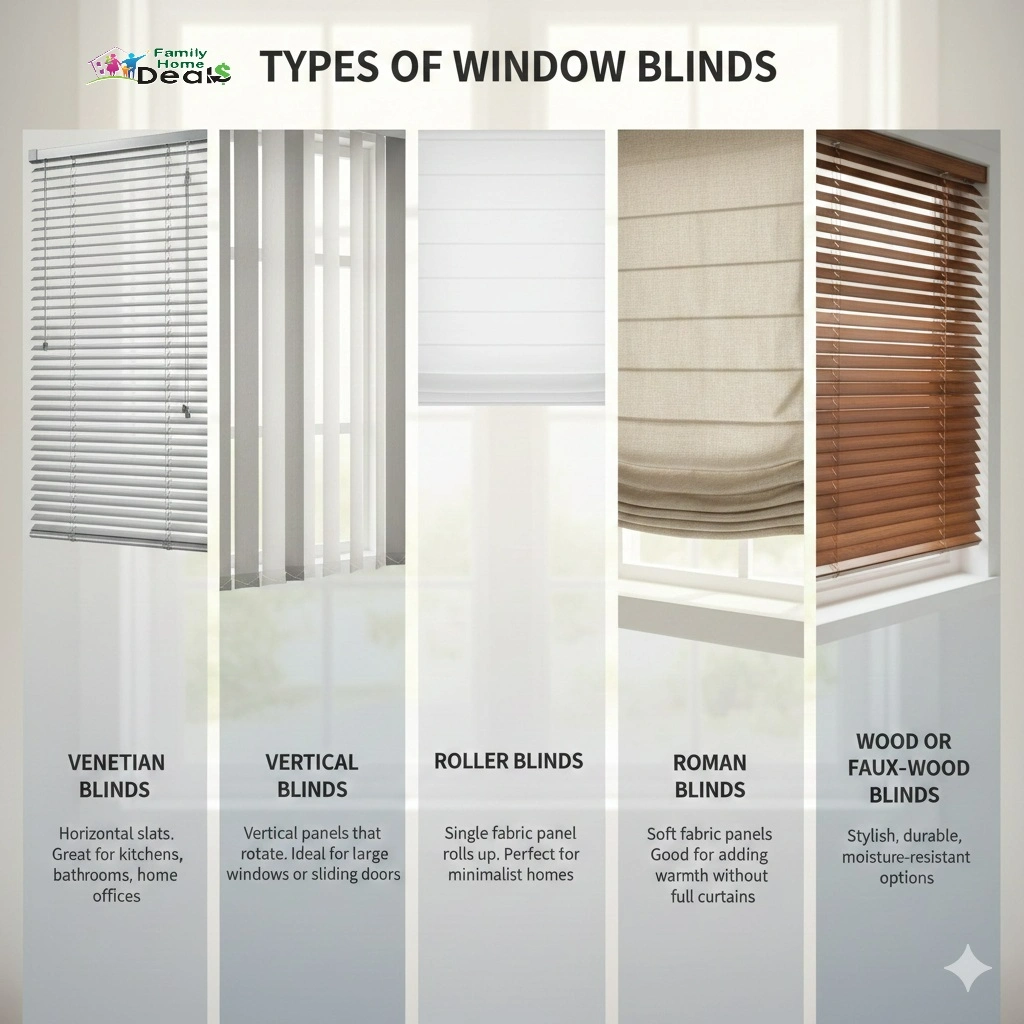
Choosing between window blinds or curtains may seem simple at first, but once you start comparing style, privacy, light control, cleaning, budget, and long-term use, the decision becomes much more complex. Homeowners often struggle with figuring out which option suits their space, lifestyle, and personal taste. The good news? With the right guidance, the choice becomes much easier.
When you understand how each option performs in real homes—not just in showrooms—you can match your window treatments to your everyday needs. Whether you want a cozy bedroom, a bright kitchen, a professional home office, or a welcoming living room, knowing the strengths and drawbacks of window blinds or curtains will help you make the best decision. In this guide, we’ll walk through real-life examples, expert-backed insights, practical tips, and research-backed information to help you choose wisely and confidently.
Why the Window Treatment Decision Matters More Than You Think
Your choice between window blinds or curtains affects more than the look of your home. It influences your home’s:
-
Temperature regulation
-
Energy efficiency
-
Light control
-
Privacy
-
Noise levels
-
Mood and ambiance
-
Cleaning routines
-
Long-term costs
In many cases, the right window treatment can lower energy bills, protect furniture from fading, offer better sleep quality, and even make rooms look larger or cozier. Because window coverings are something you use daily, making the wrong choice can lead to frustration, discomfort, or unnecessary spending.
This article will take you through everything you need to know—practical tips, comparisons, case studies, expert sources, and lifestyle-based advice—to help you choose the best option for your home.
Blinds vs. Curtains: A Full Comparison
Below is a quick overview comparing window blinds or curtains across key factors.
| Feature | Window Blinds | Curtains |
|---|---|---|
| Light Control | Excellent precision | Good but less precise |
| Privacy | Adjustable | Depends on fabric thickness |
| Cleaning | Easier, requires dusting | Harder, often requires washing |
| Style Options | Modern, minimal | Soft, warm, and decorative |
| Cost | Often more affordable | Can be budget-friendly or expensive |
| Energy Efficiency | Moderate | High, especially blackout and thermal |
| Installation | Faster and simpler | May require rods, anchors, and measurements |
| Durability | Long-lasting | Depends greatly on fabric |
Understanding Window Blinds
Blinds are structured window coverings made from materials like wood, faux wood, vinyl, fabric, and aluminum. They use slats (also called louvers) that tilt, open, or close.

Advantages of Blinds
-
Total precision with light control
You can tilt slats to let in partial light—something curtains can’t match. -
Better privacy during the day
You control what can be seen inside without blocking daylight. -
Ideal for moisture-prone rooms
Great for kitchens and bathrooms because they don’t absorb moisture like fabric. -
Easy to clean
Just dust or wipe. -
Long-lasting materials
Metal, vinyl, and faux wood hold up well over the years.
Disadvantages of Blinds
-
Can look too “office-like” in cozy rooms
Some blinds feel more functional than luxurious. -
No sound insulation
They block light but not noise. -
Can be noisy
Slats rattle, especially when windows are open.
Understanding Curtains
Curtains are fabric panels hung on rods. They come in many styles, including sheer, blackout, thermal, layered, and decorative drapes.

Advantages of Curtains
-
Excellent insulation
According to the U.S. Department of Energy, thermal curtains can reduce heat loss by up to 25%.
Superior noise reduction
Thick, layered curtains can soften sounds and improve room acoustics. -
Stylish and transformative
Curtains can make a room feel taller, larger, cozier, or more elegant. -
Safe and quiet
Ideal for nurseries or shared bedrooms.
Disadvantages of Curtains
-
Harder to clean
Many require machine washing or dry cleaning. -
Less precise with light control
You can open or close them, but not fine-tune the light. -
Not suitable for bathrooms or kitchens
Fabric can absorb moisture, odor, and grease.
Which One Is Better for Light Control?
Light control is one of the biggest factors when comparing window blinds or curtains.

Blinds Are Better When You Need Precision
Blinds allow you to:
-
Tilt slats
-
Adjust angles
-
Let in mid-level light
-
Maintain privacy while brightening the room
This makes blinds a top choice for:
-
Home offices
-
Kitchens
-
Living rooms
Curtains Are Better When You Need Darkness
Blackout curtains can block 90–100% of light, depending on the material. They’re ideal for:
-
Bedrooms
-
Nurseries
-
TV rooms
-
Night shift workers
Real-life Example:
A family living near a busy street struggled with early morning light. Once they switched to double-layered blackout curtains, both adults and children slept better, and the rooms stayed cooler in summer.
Which One Offers Better Privacy?
Both window blinds or curtains offer privacy, but they work differently.
Blinds = Adjustable Privacy
-
Tilt slats upward: lets in daylight while blocking street-level views
-
Adjust throughout the day depending on the angle of the sun
Curtains = Privacy Only When Closed
Sheers offer daytime privacy but become see-through at night. Thick curtains offer great night privacy but block daylight.
Tip:
Pairing blinds with sheer curtains offers the best of both worlds.
Which One Is More Energy-Efficient?
Curtains Win for Insulation
According to the U.S. Department of Energy, well-fitted curtains can reduce heat loss by up to 25% and reduce heat gain in summer by up to 33%.
Blinds Offer Moderate Efficiency
Blinds help reduce heat gain but don’t seal the window area like curtains.
Best Setup for Energy Savings:
Blinds + thermal curtains
This combination traps heat in winter and blocks heat in summer.
Which One Fits Your Lifestyle Better?
When deciding between window blinds or curtains, consider how you live day-to-day.
Choose Blinds If You…
-
Prefer low maintenance
-
Don’t want to wash large fabric panels
-
Need fast, precise light control
-
Cook frequently (blinds won’t absorb odors)
-
Want a clean, modern, minimal look
Choose Curtains If You…
-
Want a warm, cozy aesthetic
-
Prefer sound insulation
-
Need complete darkness for sleep
-
Love textiles, patterns, and décor
-
Have young children who nap during the day
Common Mistakes People Make When Choosing Window Blinds or Curtains
-
Ignoring the purpose of the room
-
Example: Installing sheer curtains in a bedroom when blackout is needed.
-
-
Choosing the wrong fabric
-
Heavy fabrics in humid rooms lead to mildew.
-
-
Not measuring correctly
-
Curtains that are too short or blinds that don’t fully cover the window look unfinished.
-
-
Skipping safety features
-
Cords on blinds can be dangerous for children and pets. Use cordless models.
-
-
Choosing the wrong mounting method
-
Inside mounts can make blinds look sleek but might let in gaps of light.
-
-
Not considering airflow
-
Curtains may block vents or airflow when closed.
-
Transform your living space with Smart Wings Home
Smartwings innovative design meets effortless style from chic furniture to smart home essentials; every piece is crafted to elevate comfort and functionality. Make your house feel like a dream home with products that combine quality, elegance, and practicality. Explore smartwingshome.com today and give your home the upgrade it deserves.
Step-by-Step Guide to Choosing Window Blinds or Curtains
Step 1: Identify the Room’s Needs
Ask yourself:
-
Do I need privacy?
-
Do I need darkness?
-
Do I want a cozy feel or a modern look?
-
Is this room exposed to moisture or heat?
Step 2: Decide on Light Levels
-
High precision → blinds
-
Total darkness → blackout curtains
Step 3: Measure Correctly
Use a measuring tape to record:
-
Width
-
Height
-
Inside/outside mount preferences
Follow measurement guides from trusted sources: Home Depot’s guide
Step 4: Compare Materials
-
Bathrooms: choose vinyl or aluminum blinds
-
Bedrooms: blackout or thermal curtains
-
Living rooms: layered curtains or wood blinds
Step 5: Set a Budget
Blinds typically cost less upfront. Curtains can become expensive depending on the fabric and hardware.
Step 6: Combine When Needed
Many homes use both:
-
Blinds for light control
-
Curtains for style and insulation
This is increasingly common in modern interior design.
Real-Life Case Studies
Case Study 1: The Busy Parents
A couple with two toddlers struggled with early morning light and outside noise. They switched to thermal blackout curtains, and this resulted in:
-
Better sleep for the kids
-
Reduced noise from passing cars
-
Lower heating bills
Case Study 2: The Remote Worker
A content creator needed control over lighting for video shoots. Blinds allowed him to adjust lighting without opening or closing a full curtain, improving productivity and video quality.
Case Study 3: The Minimalist Couple
They wanted a sleek, clutter-free aesthetic. Faux-wood blinds offered clean lines, low maintenance, and moisture resistance—perfect for their kitchen-heavy lifestyle.
Seasonal and Lifestyle Considerations
Summer
-
Blinds reflect heat
-
Curtains (especially blackout) keep rooms cooler
Winter
-
Thermal curtains prevent drafts
-
Blinds allow light in while protecting privacy
Small Apartments
-
Blinds make spaces feel larger
-
Curtains can visually shrink small rooms unless hung high and wide
Fashion and Aesthetic Trends
-
Minimalist homes lean toward blinds
-
Cozy, layered homes favor curtains
-
Scandinavian designs often pair blinds with flowing sheers
-
Modern homes use roller blinds + neutral curtains
FAQs About Choosing Window Blinds or Curtains
1. Can I mix both blinds and curtains?
Absolutely. Many designers recommend pairing them for maximum style and function.
2. Which lasts longer?
Blinds generally last longer because they’re made of durable materials.
3. Are blinds or curtains more child-friendly?
Cordless blinds and curtains are both safe, but long drapes may be tempting for kids to tug on.
4. Which is better for pets?
Blinds can bend or break if pets paw at them. Curtains may be safer but can collect hair.
5. What’s the most energy-efficient choice?
Thermal curtains offer the best insulation, especially when paired with blinds.
Conclusion
Choosing between window blinds or curtains becomes much easier once you understand what each one offers and how they align with your home’s needs. Blinds bring precision, durability, and modern simplicity, making them excellent for busy rooms, functional spaces, and anyone who wants clean light control. Curtains, on the other hand, bring warmth, softness, energy savings, and style—making them ideal for bedrooms, living rooms, and spaces where comfort and ambiance matter most.
The best choice ultimately depends on your lifestyle, personal taste, and daily habits. If you want precise control and minimal cleaning, blinds will likely be your best match. If you want warmth, insulation, and decorative impact, curtains will give you more benefits. Many homeowners find that combining both offers the perfect balance of beauty and function. Whichever path you choose, making an informed decision will help you create a home that feels comfortable, stylish, and tailored to your needs for years to come.


